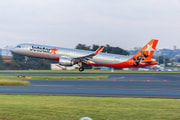Discover how Australia's top pension funds are beating the world—are yours keeping up?
- Replies 2
Australia's pension funds are not just a cornerstone of retirement security for many Australians; they're also making waves on the global stage.
With 17 of the country's not-for-profit super funds now ranked in the top 300 globally, it's clear that the Land Down Under is punching well above its weight in the pension arena.
This is a testament to the robustness of Australia's superannuation system and the savvy management of these funds.
The Thinking Ahead Institute’s Global Top 300 Pension Fund report, published on September 9, shines a spotlight on the impressive performance of Australia's super funds.
AustralianSuper, a heavyweight in the industry, has climbed two spots to sit at 16th in the world, boasting a staggering $US204.63 billion ($AU305.78 billion) under management.
This is a significant achievement, considering the intense competition on the global pension stage.

However, the success story doesn't end there. All but one of the seven Australian funds in the top 100 have seen improvements in their rankings.
The Australian Retirement Trust, despite dropping one place to 22nd, remains a strong contender.
Rest and HESTA have also gained traction and are now positioned just outside the top 100.
The performance of Australia's industry funds has been particularly noteworthy, outpacing their government-dominated counterparts, according to Ellie Boston-Clark, Co-Head of Thinking Ahead’s Australian Investments and Governance.
‘We also see a significant growth differential and rankings move between the industry funds from 2022 to 2023 (up three positions on average) and the government-related funds (down eight positions on average),’ she pointed out.
This divergence is indicative of the dynamic nature of the superannuation sector and the agility of industry funds in navigating the investment landscape.
State Super, Super SA, and Commonwealth Super Corp are among the government-dominated funds that have lost ground, underscoring the challenges faced by these entities.
Despite the volatility that has characterised financial markets, the Australian super sector maintained a positive performance in August.
Balanced funds, with 60 to 76 per cent invested in growth assets, returned a positive 0.4 per cent for the month, according to SuperRatings.
The returns are up 2.4 per cent for the financial year to date and an impressive 10 per cent over 12 months.
Kirby Rappell, SuperRatings Executive Director, pointed out, ‘The first two months of the new financial year have seen greater volatility returning.’
‘Sharemarkets have had a strong impact on fund returns. However, the need to focus on long-term outcomes rather than getting caught up in daily movements is as important as ever.’
The median growth option, with between 77 and 90 per cent growth assets, increased by 0.3 per cent in August, while the median capital stable option, with a lower exposure to shares, rose by an estimated 0.5 per cent.
These figures are encouraging for those invested in super funds, as they demonstrate resilience in the face of market fluctuations.
Globally, pension funds have enjoyed good growth in 2023, with the top 300 pension funds’ assets under management (AUM) growing 10 per cent to $US22.6 trillion ($AU33.4 trillion).
This is a significant rebound from the previous year, which saw a 13 per cent decline.
The investment strategies of these funds are diverse, with the top 20 largest pension funds globally investing about 43 per cent of their assets in equities, 35 per cent in fixed income, and 22 per cent in alternative investments like private equity and infrastructure, along with cash.
Australia stands out in this global context, with pension funds overall having 54.8 percent of their money in shares, both local and international.
This is well above the 45 per cent average for the Asia Pacific and North America, and significantly higher than Europe's 31 per cent equity exposure.
The reason for this difference lies in the structure of the superannuation schemes.
In Australia, the majority of superannuation money is in defined contribution schemes, which involve mandated member contributions, such as the super guarantee that now sits at 11.5 per cent of salaries.
In contrast, European and North Asian schemes are often defined benefit, promising a certain amount of money to the employee on retirement, leading to more conservative investment strategies.
Globally, defined benefit funds account for 60.8 per cent of pension assets, while defined contribution funds account for only 26.4 per cent.
The top 20 fund list is dominated by national schemes like those of Japan, Korea, Canada, and Norway, where national pension commitments are held in one fund rather than multiple competitors as in the Australian system.
Australia may be a small player globally, with only 5.1 per cent of pension assets under management, but it's growing at a remarkable pace.
Just a year earlier, the country's superannuation assets accounted for only 4.1 per cent of the global figure.
The AUM of the top 20 funds increased by 11.6 per cent in 2023, compared to the 10.0 per cent increase for the top 300 funds.
This growth trajectory is a clear indication that when it comes to pensions, Australia is a force to be reckoned with.
‘Looking at the compound annual growth rate for the last five years, the top 20 have shown higher growth rates than the top 300 funds—5.4 per cent and 4.7 per cent respectively,’ the report stated.
For our readers over 60, this news is both reassuring and exciting. It means that your retirement funds are not only secure but are also performing at a level that's recognised internationally.
It's essential to stay informed about how your super fund is performing and to understand the strategies they're employing to maximize your retirement savings.
If you're not already with one of these top-performing funds, it might be time to review your superannuation strategy and consider whether your current fund is keeping up with the best.
As Australia's leading superannuation funds continue to make headlines with their impressive performance, it's essential for retirees and those planning for retirement to stay informed about the latest opportunities to maximise their savings.
With top funds showing notable progress, the recent rate hike offers a timely boost for enhancing your retirement bank.
Exploring these developments can help you make the most of your superannuation strategy and ensure a more secure financial future.
 How do you feel about the performance of your super fund? Are you considering a switch, or are you satisfied with where your retirement savings are sitting? Share your thoughts and experiences in the comments below, and let's discuss the future of our super together.
How do you feel about the performance of your super fund? Are you considering a switch, or are you satisfied with where your retirement savings are sitting? Share your thoughts and experiences in the comments below, and let's discuss the future of our super together.
With 17 of the country's not-for-profit super funds now ranked in the top 300 globally, it's clear that the Land Down Under is punching well above its weight in the pension arena.
This is a testament to the robustness of Australia's superannuation system and the savvy management of these funds.
The Thinking Ahead Institute’s Global Top 300 Pension Fund report, published on September 9, shines a spotlight on the impressive performance of Australia's super funds.
AustralianSuper, a heavyweight in the industry, has climbed two spots to sit at 16th in the world, boasting a staggering $US204.63 billion ($AU305.78 billion) under management.
This is a significant achievement, considering the intense competition on the global pension stage.

Australia's superannuation sector is gaining global acclaim, with 17 not-for-profit funds ranking in the top 300 worldwide. Credit: Shutterstock
However, the success story doesn't end there. All but one of the seven Australian funds in the top 100 have seen improvements in their rankings.
The Australian Retirement Trust, despite dropping one place to 22nd, remains a strong contender.
Rest and HESTA have also gained traction and are now positioned just outside the top 100.
The performance of Australia's industry funds has been particularly noteworthy, outpacing their government-dominated counterparts, according to Ellie Boston-Clark, Co-Head of Thinking Ahead’s Australian Investments and Governance.
‘We also see a significant growth differential and rankings move between the industry funds from 2022 to 2023 (up three positions on average) and the government-related funds (down eight positions on average),’ she pointed out.
This divergence is indicative of the dynamic nature of the superannuation sector and the agility of industry funds in navigating the investment landscape.
State Super, Super SA, and Commonwealth Super Corp are among the government-dominated funds that have lost ground, underscoring the challenges faced by these entities.
Despite the volatility that has characterised financial markets, the Australian super sector maintained a positive performance in August.
Balanced funds, with 60 to 76 per cent invested in growth assets, returned a positive 0.4 per cent for the month, according to SuperRatings.
The returns are up 2.4 per cent for the financial year to date and an impressive 10 per cent over 12 months.
Kirby Rappell, SuperRatings Executive Director, pointed out, ‘The first two months of the new financial year have seen greater volatility returning.’
‘Sharemarkets have had a strong impact on fund returns. However, the need to focus on long-term outcomes rather than getting caught up in daily movements is as important as ever.’
The median growth option, with between 77 and 90 per cent growth assets, increased by 0.3 per cent in August, while the median capital stable option, with a lower exposure to shares, rose by an estimated 0.5 per cent.
These figures are encouraging for those invested in super funds, as they demonstrate resilience in the face of market fluctuations.
Globally, pension funds have enjoyed good growth in 2023, with the top 300 pension funds’ assets under management (AUM) growing 10 per cent to $US22.6 trillion ($AU33.4 trillion).
This is a significant rebound from the previous year, which saw a 13 per cent decline.
The investment strategies of these funds are diverse, with the top 20 largest pension funds globally investing about 43 per cent of their assets in equities, 35 per cent in fixed income, and 22 per cent in alternative investments like private equity and infrastructure, along with cash.
Australia stands out in this global context, with pension funds overall having 54.8 percent of their money in shares, both local and international.
This is well above the 45 per cent average for the Asia Pacific and North America, and significantly higher than Europe's 31 per cent equity exposure.
The reason for this difference lies in the structure of the superannuation schemes.
In Australia, the majority of superannuation money is in defined contribution schemes, which involve mandated member contributions, such as the super guarantee that now sits at 11.5 per cent of salaries.
In contrast, European and North Asian schemes are often defined benefit, promising a certain amount of money to the employee on retirement, leading to more conservative investment strategies.
Globally, defined benefit funds account for 60.8 per cent of pension assets, while defined contribution funds account for only 26.4 per cent.
The top 20 fund list is dominated by national schemes like those of Japan, Korea, Canada, and Norway, where national pension commitments are held in one fund rather than multiple competitors as in the Australian system.
Australia may be a small player globally, with only 5.1 per cent of pension assets under management, but it's growing at a remarkable pace.
Just a year earlier, the country's superannuation assets accounted for only 4.1 per cent of the global figure.
The AUM of the top 20 funds increased by 11.6 per cent in 2023, compared to the 10.0 per cent increase for the top 300 funds.
This growth trajectory is a clear indication that when it comes to pensions, Australia is a force to be reckoned with.
‘Looking at the compound annual growth rate for the last five years, the top 20 have shown higher growth rates than the top 300 funds—5.4 per cent and 4.7 per cent respectively,’ the report stated.
For our readers over 60, this news is both reassuring and exciting. It means that your retirement funds are not only secure but are also performing at a level that's recognised internationally.
It's essential to stay informed about how your super fund is performing and to understand the strategies they're employing to maximize your retirement savings.
If you're not already with one of these top-performing funds, it might be time to review your superannuation strategy and consider whether your current fund is keeping up with the best.
As Australia's leading superannuation funds continue to make headlines with their impressive performance, it's essential for retirees and those planning for retirement to stay informed about the latest opportunities to maximise their savings.
With top funds showing notable progress, the recent rate hike offers a timely boost for enhancing your retirement bank.
Exploring these developments can help you make the most of your superannuation strategy and ensure a more secure financial future.
Key Takeaways
- Australia's superannuation industry is gaining global recognition with 17 not-for-profit super funds ranked in the top 300 internationally.
- AustralianSuper is leading the nation on the global stage, currently ranked 16th in the world with $US204.63 billion ($AU305.78 billion) under management.
- The superannuation assets under management (AUM) in Australia grew strongly, accounting for 5.1 per cent of the global pension assets in 2023, up from 4.1 per cent the previous year.
- Overall, global pension funds experienced a 10 per cent increase in AUM to $US22.6 trillion in 2023, with the top 20 funds showing higher growth rates than the top 300 over the last five years.







